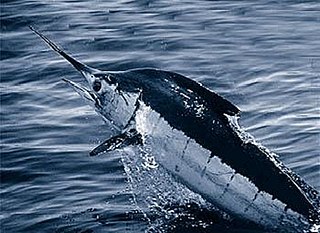
A tuna is a saltwater fish that belongs to the tribe Thunnini, a subgrouping of the Scombridae (mackerel) family. The Thunnini comprise 17 species across five genera, the sizes of which vary greatly, ranging from the bullet tuna up to the Atlantic bluefin tuna, which averages 2 m (6.6 ft) and is believed to live up to 50 years.

Mackerel is a common name applied to a number of different species of pelagic fish, mostly from the family Scombridae. They are found in both temperate and tropical seas, mostly living along the coast or offshore in the oceanic environment.

Herring are various species of forage fish, mostly belonging to the family Clupeidae.

The term carp is a generic common name for numerous species of freshwater fish from the family Cyprinidae, a very large clade of ray-finned fish mostly native to Eurasia. While carp are prized quarries and are valued as both food and ornamental fish in many parts of the Old World, they are considered trash fish and invasive pests in many parts of Africa, Australia and most of the United States.

Sardine and pilchard are common names for various species of small, oily forage fish in the herring suborder Clupeoidei. The term 'sardine' was first used in English during the early 15th century; a somewhat dubious etymology says it comes from the Italian island of Sardinia, around which sardines were once supposedly abundant.

Wobbegong is the common name given to the 12 species of carpet sharks in the family Orectolobidae. They are found in shallow temperate and tropical waters of the western Pacific Ocean and eastern Indian Ocean, chiefly around Australia and Indonesia, although one species occurs as far north as Japan. The word wobbegong is believed to come from an Australian Aboriginal language, meaning "shaggy beard", referring to the growths around the mouth of the shark of the western Pacific.

The billfish are a group of saltwater predatory fish characterised by prominent pointed bills (rostra), and by their large size; some are longer than 4 m (13 ft). Extant billfish include sailfish and marlin, which make up the family Istiophoridae; and swordfish, sole member of the family Xiphiidae. They are often apex predators which feed on a wide variety of smaller fish, crustaceans and cephalopods. These two families are sometimes classified as belonging to the order Istiophoriformes, a group which originated around 71 million years ago in the Late Cretaceous, with the two families diverging around 15 million years ago in the Late Miocene. However, they are also classified as being closely related to the mackerels and tuna within the suborder Scombroidei of the order Perciformes. However, the 5th edition of the Fishes of the World does recognise the Istiophoriformes as a valid order, albeit including the Sphyraenidae, the barracudas.
Telmatherina abendanoni is a species of fish in the subfamily Telmatherininae part of the family Melanotaeniidae, the rainbowfishes. It is endemic to Indonesia where it occurs only in Lake Matano on the island of Sulawesi.
Telmatherina antoniae is a species of fish in the subfamily Telmatherininae part of the family Melanotaeniidae, the rainbowfishes. It is endemic to Indonesia where it occurs only in Lake Matano on Sulawesi.
Telmatherina bonti is a species of fish in the subfamily Telmatherininae part of the family Melanotaeniidae, the rainbowfishes. It is endemic to Indonesia where it is found in Lake Towuti, near Malili and in Lake Mahalona all on Sulawesi.

Telmatherina celebensis, also known as the Celebes rainbow, is a species of fish in the subfamily Telmatherininae part of the family Melanotaeniidae, the rainbowfishes. It is endemic to the island of Sulawesi in Indonesia where it has been found to occur in Lakes Towuti and Mahalona, and may also occur in Lake Wawontoa. This species was described in 1897 by George Albert Boulenger from a type locality of Lake Towuti.
Telmatherina obscura is a species of fish in the subfamily Telmatherininae part of the family Melanotaeniidae, the rainbowfishes. It is endemic to Indonesia. The species was described in 1991 by Maurice Kottelat with a type locality of Mengonuwai on Lake Matano on the island of Sulawesi.
Telmatherina opudi is a species of fish in the subfamily Telmatherininae part of the family Melanotaeniidae, the rainbowfishes. It is endemic to Indonesia. his species was described in 1991 by Maurice Kottelat from a type locality of Lake Matano.
Telmatherina prognatha is a species of fish in the subfamily Telmatherininae part of the family Melanotaeniidae, the rainbowfishes. It is endemic to Indonesia, where it occurs only in Lake Matano on the island of Sulawesi.
Telmatherina sarasinorum is a species of fish in the subfamily Telmatherininae part of the family Melanotaeniidae, the rainbowfishes. It is endemic to Indonesia, where it occurs only in Lake Matano on the island of Sulawesi. This species was described in 1991 by Maurice Kottelat, the types being collected at Mengonuwai on Lake Matano.
Telmatherina wahjui is a species of fish in the subfamily Telmatherininae, which is part of the family Melanotaeniidae; the rainbowfishes. It is endemic to Indonesia, where it occurs only in Lake Matano on the island of Sulawesi. It can reach a maximum length of around 5 centimetres (2.0 in). This species was described in 1991 by Maurice Kottelat with a type locality of Alaponkepi which is situated at the outlet of Lake Matano.

An anchovy is a small, common forage fish of the family Engraulidae. Most species are found in marine waters, but several will enter brackish water, and some in South America are restricted to fresh water.

Fritz Sarasin, full name Karl Friedrich Sarasin was a Swiss naturalist.










